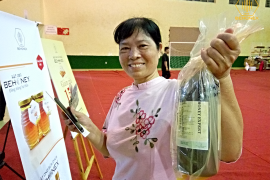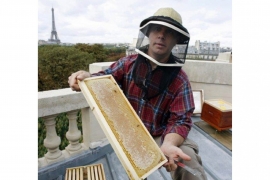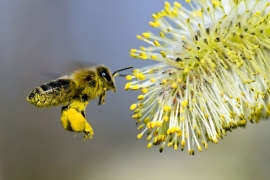ABOUT HONEYBEES
- 10:30, 28/03/2016
- 6918
- 10 bình luận
What is a honeybee?

Honeybees are flying insects, and close relatives of and ants. They are found on every continent on earth, except for Antarctica.
Bees of all varieties live on nectar and pollen. Without bees, pollination would be difficult and time consuming - it is estimated that one-third of the human food supply depends on insect pollination. Bees have a long, straw-like tongue called a probiscus that allows them to drink the nectar from deep within blossoms. Bees are also equipped with two wings, two antennae, and three segmented body parts (the head, the thorax, and the abdomen). Honeybees are social insects that live in colonies. The hive population consists of a single queen, a few hundred drones, and thousands of worker bees.

Worker Bees
Worker bees are the most familiar-looking member of the honeybee hive, as they make up about 99% of each colony's population.
Worker bees are all female, and they do almost everything for the hive. From birth to her death 45 days later, the worker bee is given different tasks to do during different stages of her life. Worker bees are responsible for everything from feeding the larvae (the baby bees), to tending to the queen, to cleaning the hive, to collecting food, to guarding the colony, to building honeycomb.
The stinger of the worker bee is barbed, so when she is forced to defend herself or the hive, her stinger will become stuck in the skin of her victim. She is unable to pull it out, and dies Consequently, honeybees are very gentle - they don't want to die any more than you want to be stung. Be nice to them, and they'll be nice to you.

Drone Bees
Their job is to mate with queens from other hives and they die immediately afterwards. If they do not mate, they can live up to 90 days (that's twice as long as a worker bee!)
You can identify drones in the hive by their big round bodies and large eyes. Drones are incapable of stinging.

Queen Bee
There is one queen bee per hive - she is the mom of all the other bees. She is the only fertile member of the colony, and lays about 1,500 eggs a day during spring and summer.
Queen bees are distinguished from the other members of the hive by their long abdomens and small wings. Soon after birth, queen bees will go out and have a wild weeked, where they mate with 15 or more drones over a three day period before retiring to the hive to lay eggs. The queen will not leave the hive again unless the colony swarms (looking for a new home).
When the colony needs a new queen bee, they simply choose a healthy larva, hatched from an egg of the current queen, and feed it royal jelly, a special, super-nutrious food. Royal jelly, produced in the heads of young nurse bees (worker bees whose job it is to care for the larvae), helps this larva grow into a queen. Queens can lay about 1,500 eggs per day and can live from 4 to 7 years, that's up to 57 times longer than a worker bee - it's no wonder humans love adding royal jelly to their diets, too!

Life in the Hive
Honey bees normally build the inside of their hive. They make their own special wax (beeswax), which they use to create perfect little hexagons inside their home. These little cubbyholes are called cells, and in them, the bees store everything from eggs, to pollen, to honey.
To seal their hive and to protect against diseases, the bees make a substance called propolis. Propolis is a combination of beeswax, honey, and tree resins, and is anti-bacterial, anti-fungal, and anti-viral. It is also very sticky, and honeybees love to use it to seal up any cracks or holes they may encounter on a housekeeping mission.
With such a large population all working together, some great communication skills are needed. Bees do their talking in two ways - by scent and by dancing. When a honeybee is warning her sisters about an intruder, or if all the ladies in the hive are particularly happy, honeybees have the ability to release a special hormonal scent called pheromones. The bees can detect these scents and interpret their message. A happy bee pheromone smells suspiciously like lemons, and a warning-smell has a banana-like scent.
When a forager bee needs to alert her sisters as to where a nectar source is, dancing comes in handy. She does special turns and wiggles to show where she found the food - essentially drawing a map.








